In the intricate dance of competition, where triumph and defeat hang in the balance, how do we truly quantify skill? For centuries, this question was a subjective riddle. Then, a quiet physicist and chess master stepped forward with an elegant solution that would forever change the landscape of competitive sports. This is the story of Arpad Elo, the man behind the numbers that define greatness.
The Uncommon Mind of Arpad Elo
Born 122 years ago in the Kingdom of Hungary, Arpad Emmerich Elo’s journey led him across the Atlantic to the United States in 1913. It was there, amidst the burgeoning scientific and academic world, that he cultivated a unique blend of intellect. A physicist by profession, teaching at Marquette University for over four decades, Elo possessed a rigorous scientific mind. Yet, his passion extended beyond the laboratory to the 64 squares of the chessboard, where he excelled as a formidable master. He dominated the Milwaukee chess scene, a national hub at the time, winning the Wisconsin State Championship an impressive eight times and earning a rightful place in the World Chess Hall of Fame.
This dual expertise – the analytical precision of a scientist and the practical understanding of a top-tier competitor – positioned him uniquely to tackle one of competitive chess`s most pressing issues: the lack of a standardized, objective method to rank players.
The Birth of an Elegant System
Before Elo, chess rankings often relied on ad-hoc systems, subjective assessments, or simple win-loss records that failed to account for the strength of an opponent. The need for a more sophisticated approach was evident as the game grew globally. Elo recognized that a player`s performance wasn`t just about winning or losing, but about how they performed relative to expectations.
His stroke of genius lay in developing a statistical model that could predict the outcome of a game based on the difference in skill between two players. The core idea is beautifully simple: if you play an opponent with a higher rating, winning earns you more points, while losing costs you fewer. Conversely, beating a lower-rated player brings modest gains, and a loss is quite penalizing. This constant recalibration ensures that ratings reflect a dynamic, evolving measure of performance against a pool of peers.
First adopted by the US Chess Federation in 1960, the Elo system quickly demonstrated its unparalleled fairness and accuracy. Its elegance was further amplified by the technological advancements of the 1970s. The advent of the pocket calculator and commercial microprocessors transformed the previously arduous task of calculating ratings into a manageable process, paving the way for its wider acceptance.
From Chessboards to Global Arenas: A Universal Language of Skill
The year 1970 marked a pivotal moment when FIDE, the International Chess Federation, officially embraced Elo’s system. Just a year later, the first FIDE rating list was published, anointing Bobby Fischer as the world`s top player with a then-unprecedented 2760 rating, followed closely by reigning World Champion Boris Spassky. This list provided an objective hierarchy, a common language through which skill could be universally understood and discussed.
The impact of the Elo system extended far beyond chess. Its underlying principles, adaptable to any two-player or team-based competitive scenario, soon found applications in a multitude of sports and games. From football and baseball to basketball and even online gaming, the Elo system (or variations thereof) became the de facto standard for ranking competitors, allowing fans and professionals alike to track progress, compare abilities, and identify rising stars with unprecedented clarity.
A Living Legacy: Evolution and the Pursuit of Perfection
While the core of the Elo system remains robust, it is not a static relic. Like any living system, it has continuously evolved to meet the demands of a rapidly changing competitive landscape. From once-a-year publications, FIDE`s rating lists now update monthly, reflecting the accelerated pace of tournaments and player development.
The system has also produced fascinating statistical milestones, offering a clear lens into the progression of human skill. Grandmaster titles, for instance, are tied to reaching a 2500 rating. The pinnacle of this numerical achievement belongs to Magnus Carlsen, who ascended to a staggering 2882, an achievement that seemed almost mythical in earlier eras. Only a handful of players in history have managed to cross the elite 2800 threshold, a testament to both their individual genius and the system`s ability to precisely delineate these stratospheric levels of play.
More recently, the system has faced new challenges, such as “rating inflation” – the phenomenon of ratings gradually increasing across the board, particularly among new and beginner players. In response, FIDE implemented a significant update in 2024 to fine-tune the algorithm, ensuring that the system remains fair, accurate, and relevant for a rapidly expanding global base of players, including millions of children and aspiring chess enthusiasts.
Beyond the Scoreboard: Elo`s Enduring Impact
Arpad Elo`s contribution is more than just an algorithm; it`s a foundational pillar of modern competitive culture. He provided the tools to objectify skill, allowing for fair comparison, tracking progress, and fostering a clear path for aspiration. His system doesn`t just rank players; it inspires them to strive for improvement, offering tangible feedback on their journey.
In a world often riddled with subjective judgments, Elo offered clarity and a democratic means of assessing talent. His legacy is etched not just in the annals of chess history, but in every competitive field where the question of “who is best?” is answered with a precise, elegant number. Arpad Elo, the quiet physicist, truly built a universal language for competitive excellence.






